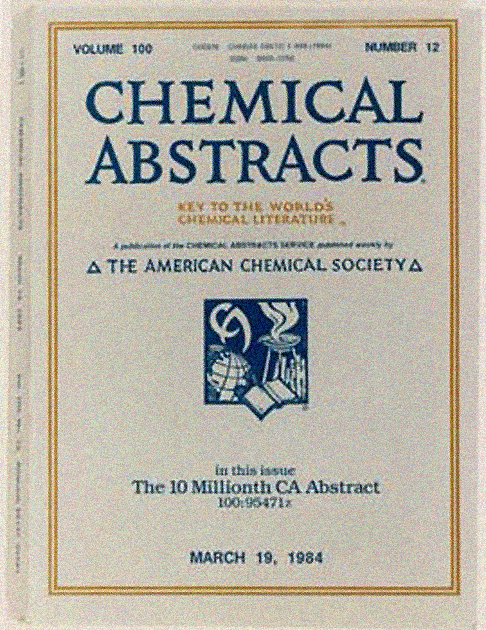

 Chemical Abstracts was published in print from 1907 to 2009 by the American Chemical Society. In the decades before computer databases, large indexes like CA were the standard entry point into the scientific literature. Using them effectively was a skill that required learning, dedication, and practice. A complete set of CA, with Collective Indexes, from 1907 through 2001, is located in remote storage.
Chemical Abstracts was published in print from 1907 to 2009 by the American Chemical Society. In the decades before computer databases, large indexes like CA were the standard entry point into the scientific literature. Using them effectively was a skill that required learning, dedication, and practice. A complete set of CA, with Collective Indexes, from 1907 through 2001, is located in remote storage.
Abstracts
There were 26 weekly issues per semiannual "volume." Each Abstract issue was divided into 80 Subject Sections. An abstract appeared in just one section, based on the novelty of the process or substance being reported in the literature. Each weekly issue also contained indexes by author, subject keyword (not official headings), and patent number. The issue indexes were superseded first by a volume index published every six months, and then by the 5-year Collective Index. (The library did not retain the issue and volume indexes.)
Collective Indexes
Every five years CAS published a Collective Index (CI). The 14th CI was published in 2002 and covers the years 1997-2001. The library has all Collective Indexes up to this point. They are divided into:
Index Guides
The Index Guide (IG) for each Collective Index period provides cross-references from commonly used chemical names to official CA Index Names (with registry numbers) used in the corresponding Chemical Substance Index. It also serves as a thesaurus of all controlled-vocabulary subject headings used in the General Subject Index. The Index Guide should always be consulted before looking up a chemical name or subject term in the Collective Indexes.
Ring Systems Handbook
The RSH leads you from a ring or cage structure to the CA Index Name and Registry Number of a ring parent compound, for searching in the Chemical Substance Index. Entries are in ring analysis order and are indexed by molecular formula and Index Name.
Registry Handbook
The Registry Handbook - Number Section was a cumulative numerical listing of Registry Numbers assigned to chemical substances from 1965 to 1996. If you have only a registry number and need the CA Index Name for that compound, look it up here first and then use the name to consult the Chemical Substance Indexes. A corresponding Names Section issued on microfiche provided registry numbers for several hundred thousand of the most-indexed common names.
CASSI
CASSI (Chemical Abstracts Service Source Index) is the comprehensive and retrospective list of publications that have been indexed by Chemical Abstracts since it began in 1907. It includes journals, books, conferences, and other series, arranged by CA abbreviation. This is the source you use to translate journal title abbreviations into full titles for searching in the library catalog and other finding aids. The last print edition of CASSI (1907-2004) is kept in the Librarian's office. It is also available in a somewhat limited form on the web:
Doing a manual search in printed Chemical Abstracts is a tedious, mutli-step process. This is how it was done.
| Dates | Example | Notes |
|---|---|---|
| 1967-present | 74:23628c | Represents a single specific abstract; searchable in SciFinder. The final control character appears only in the print abstracts and should be ignored. |
| 1947-66 | 45:1541e | Volume:Column number/column fraction letter a-h. Abstract numbers prior to 1967 do not necessarily represent a specific abstract, but rather the position in a column or page where that abstract begins. |
| 1934-46 | 28:37145 | Volume:Column number/column fraction digit 1-9 |
| 1907-33 | 6:571 | Volume:page only. |
 For most libraries, the increasingly rare use of historical print CA may no longer warrant the large amount of space it occupies. It ceased print production in 2009, and many libraries stopped taking it long before that. Ultimately, the decision must be based on local needs and situations. If space needs are urgent, it is quite difficult to justify keeping CA in place. If you have the luxury of considering the finer points, these are some pieces of collective wisdom gathered from experts over the years.
For most libraries, the increasingly rare use of historical print CA may no longer warrant the large amount of space it occupies. It ceased print production in 2009, and many libraries stopped taking it long before that. Ultimately, the decision must be based on local needs and situations. If space needs are urgent, it is quite difficult to justify keeping CA in place. If you have the luxury of considering the finer points, these are some pieces of collective wisdom gathered from experts over the years.

This work is licensed under a Creative Commons Attribution-NonCommercial 4.0 Generic License.